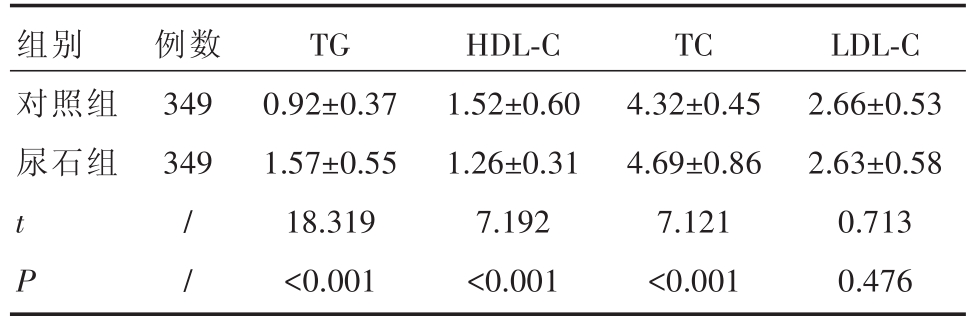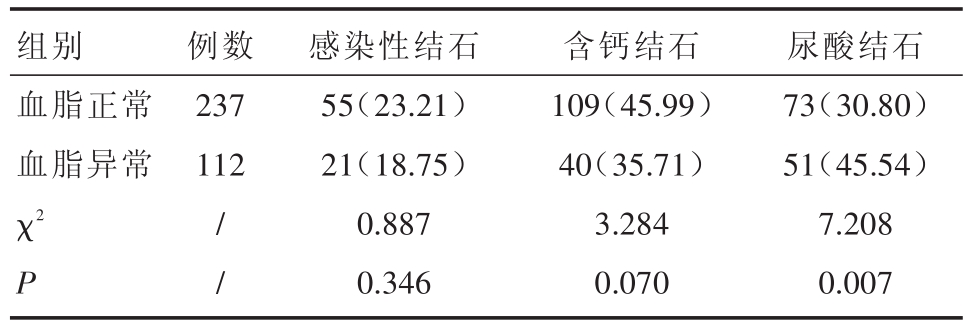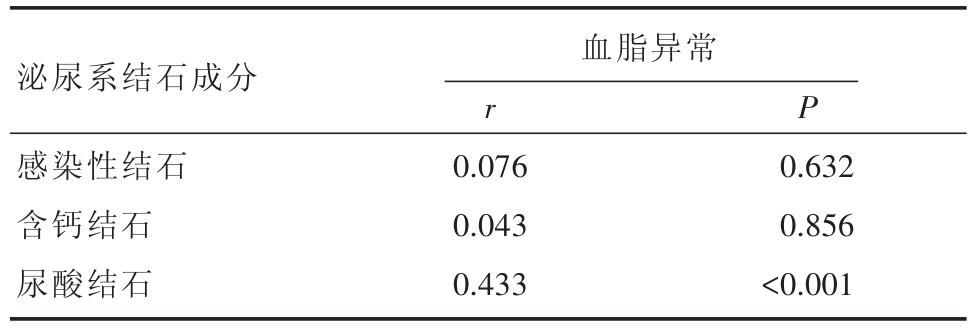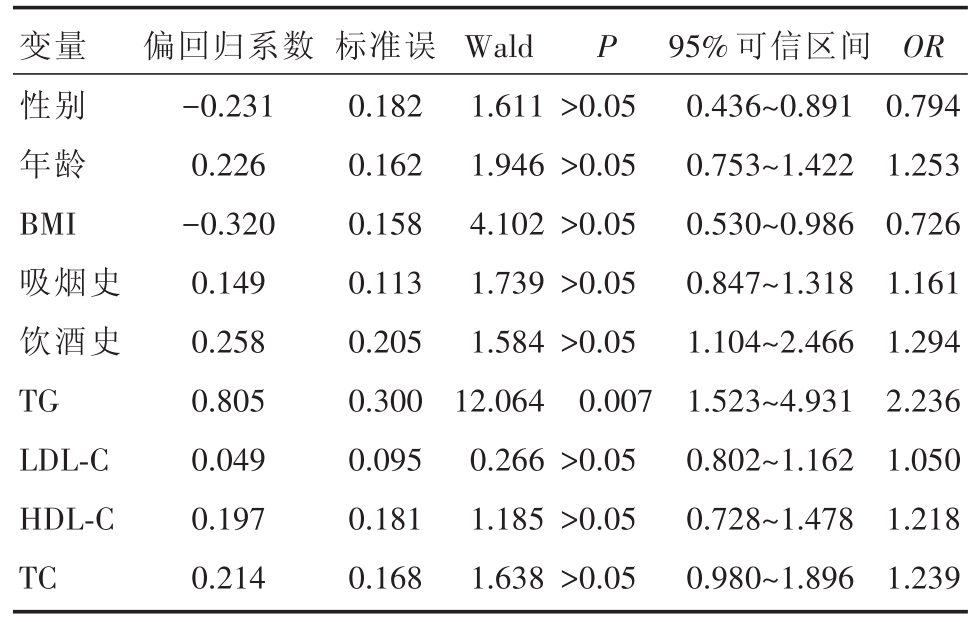泌尿系结石是泌尿外科的常见疾病之一,在泌尿外科住院病人中占首位[1]。流行病学资料显示[2]我国泌尿系结石发病率为1%~5%,其中约25%需住院治疗。随着人们工作节奏加快,饮食结构改变,生活水平提高,泌尿系结石发病率呈现逐年上升趋势[3]。泌尿系结石形成极其复杂,与脂肪代谢异常、胰岛素抵抗(insulin resistance,IR)、高血糖、高血压、肥胖等有密切关系[4]。血脂是生命细胞的基础代谢必需物质,广泛存在于人体中,能够参与人体内能量代谢[5]。有研究证实[6]脂肪代谢异常是泌尿系结石形成的重要原因,但血脂与泌尿系结石相关性的尚不清楚。因此本研究分析了泌尿系结石成分,并探讨了泌尿系结石与血脂相关性,以期为临床防治泌尿系结石提供理论依据,现将研究结果报告如下。
1 资料与方法
1.1 一般资料
回顾性选择2014年10月~2018年10月我院收治的349例泌尿系结石患者为尿石组,同期在我院体检健康者349例为对照组。尿石组:男性214例,女性135例;年龄18~67岁,平均年龄(45.21±5.46)岁;体质指数(body mass index,BMI)为(24.57±3.60)kg/m2;吸烟史 210例;饮酒史245例;泌尿系结石类型:肾结石86例,输尿管结石246例,膀胱结石18例。对照组:男性219例,女性130例;年龄18~68岁,平均年龄(44.38±5.62)岁;BMI(24.40±3.58)kg/m2;吸烟史205例;饮酒史251例。两组年龄、性别、吸烟史、BMI、饮酒史等一般资料无显著差异(P>0.05)。本研究上报我院医学伦理委员会并获得批准。
1.2 纳入排除标准
纳入标准:①尿石组均经B超、尿路平片(kidney ureter bladder,KUB)、排泄性尿路造影(intravenous pyelography,IVP)或CT尿路造影(CT urography,CTU)等确诊为泌尿系结石;②病历资料完整;③无血液疾病;④无自身免疫系统疾病;⑤无心血管疾病(cardiovascular disease,CVD);⑥所有研究对象对本研究知情了解,并签署知情同意书。排除标准:①合并心、肝、肺等重要脏器功能不全;②妊娠或哺乳期妇女;③合并恶性肿瘤、高血压、糖尿病;④凝血功能异常;⑤甲状旁腺功能亢进;⑥认知功能障碍。
1.3 研究方法
所有研究对象入院后记录年龄、性别、吸烟史、BMI、饮酒史等一般资料,采集清晨空腹外周静脉血5 mL,置于无菌真空采血管(陕西奇林医疗器械有限公司)中,采用离心机(北京时代北利离心机有限公司,型号:DT4-6D),3000 r/min离心15 min,分离血清,采用全自动生化分析仪(北京北瑞达医药科技有限公司,型号:SR95-SUNMATIK-9050)检测血清中低密度脂蛋白胆固醇(low density lipoprotein cholesterol,LDL-C)、甘油三酯(triglyceride,TG)、高密度脂蛋白胆固醇(high density lipoprotein cholesterol,HDL-C)、总胆固醇(total cholesterol,TC)水平,血脂异常判断标准参照《中国成人血脂异常防治指南(2016年修订版)》[5]。手术当日留取泌尿系结石标本,结石标本经蒸馏水清洗后自然风干,采用德国布鲁克Lumos独立式红外光谱分析仪进行结石成分分析。
1.4 统计学方法
本研究数据的统计分析在spss 22.0软件上进行,采用χ2检验比较组间计数资料,计数资料以n(%)表示,采用t检验比较组间计量资料,计量资料以(x±s)表示,采用spearman相关分析泌尿系结石成分与血脂异常的相关性,采用多因素Logistic回归分析泌尿系结石的影响因素,P<0.05表示差异具有统计学意义。
2 结 果
2.1 两组血清TG、HDL-C、TC、LDL-C水平
尿石组血清TG、TC水平显著高于对照组,差异具有统计学意义(P<0.05);尿石组血清HDL-C水平显著低于对照组,差异具有统计学意义(P<0.05);尿石组血清LDL-C水平较对照组差异无统计学意义(P>0.05)(表1)。
2.2 泌尿系结石成分分析
349例泌尿系结石患者泌尿系结石成分分析结果:含钙结石270例,包括草酸钙(一水/二水草酸钙)104例、草酸钙+磷酸钙36例、草酸钙+羟基磷灰石58例、草酸钙+尿酸54例、草酸钙+尿酸+磷酸钙18例;感染性结石51例,包括羟基磷灰石+草酸钙23例、磷酸镁铵+草酸钙14例、羟基磷灰石+磷酸镁铵4例、尿酸铵2例、磷酸镁铵+尿酸8例;尿酸结石28例,包括尿酸结石10例、尿酸+磷酸镁铵18例。
表1 两组血清TG、HDL-C、TC、LDL-C水平(x±s,mmol/L)

组别对照组尿石组例数349 349 t P/ /TG 0.92±0.37 1.57±0.55 18.319<0.001 HDL-C 1.52±0.60 1.26±0.31 7.192<0.001 TC 4.32±0.45 4.69±0.86 7.121<0.001 LDL-C 2.66±0.53 2.63±0.58 0.713 0.476
2.3 血脂正常与血脂异常的泌尿系结石患者结石成分分析
血脂异常泌尿系结石患者尿酸结石比例显著高于血脂正常泌尿系结石患者,差异具有统计学意义(P<0.05);血脂异常泌尿系结石患者感染性结石、含钙结石比例较血脂正常泌尿系结石患者差异无统计学意义(P>0.05)(表2)。
表2 血脂正常与血脂异常的泌尿系结石患者结石成分分析(例)

组别血脂正常血脂异常例数237 112 χ2 P/ /感染性结石55(23.21)21(18.75)0.887 0.346含钙结石109(45.99)40(35.71)3.284 0.070尿酸结石73(30.80)51(45.54)7.208 0.007
2.4 泌尿系结石成分与血脂异常的相关性
尿酸结石与血脂异常呈正相关(P<0.05);感染性结石、含钙结石与血脂异常无相关性(P>0.05)(表 3)。
表3 泌尿系结石成分与血脂异常的相关性

泌尿系结石成分 血脂异常P感染性结石含钙结石尿酸结石r 0.076 0.043 0.433 0.632 0.856<0.001
2.5 多因素Logistic回归分析泌尿系结石的影响因素
TG是泌尿系结石的危险因素(P<0.05)(表4、5)。
表4 多因素Logistic回归分析的赋值表

因素性别吸烟史饮酒史赋值情况男=1;女=0有=1;无=0有=1;无=0
表5 多因素Logistic回归分析泌尿系结石的影响因素

变量性别年龄BMI吸烟史饮酒史TG LDL-C HDL-C TC偏回归系数-0.231 0.226-0.320 0.149 0.258 0.805 0.049 0.197 0.214标准误0.182 0.162 0.158 0.113 0.205 0.300 0.095 0.181 0.168 Wald 1.611 1.946 4.102 1.739 1.584 12.064 0.266 1.185 1.638 P>0.05>0.05>0.05>0.05>0.05 0.007>0.05>0.05>0.05 95%可信区间0.436~0.891 0.753~1.422 0.530~0.986 0.847~1.318 1.104~2.466 1.523~4.931 0.802~1.162 0.728~1.478 0.980~1.896 OR 0.794 1.253 0.726 1.161 1.294 2.236 1.050 1.218 1.239
3 讨 论
泌尿系结石形成原因复杂,与多种因素相关。有研究显示[7]高血糖、高血压、脂肪代谢异常是泌尿系结石形成的危险因素,其中脂肪代谢异常是泌尿系结石形成的重要原因,脂肪代谢异常可使泌尿系结石发生风险增加25%~30%。有研究认为[8]血脂水平升高会导致血液粘稠度增加,发生动脉粥样硬化(atherosclerosis,AS),影响肾脏血流,促使血液中致结石物质沉积形成结石。本研究结果显示尿石组血清TG、TC水平显著高于对照组,尿石组血清HDL-C水平显著低于对照组,尿石组血清LDL-C水平较对照组无显著差异,这与陈城等[9]人研究一致,提示泌尿系结石形成与血脂异常有关。本研究多因素Logistic回归分析显示TG是泌尿系结石的危险因素,提示血脂异常尤其是高甘油三酯血症更容易导致泌尿系结石形成,控制血脂对于预防泌尿系结石有重要临床意义。
本研究纳入的349例泌尿系结石患者中,高发年龄为40~50岁,男性多于女性,男女比例为1.57∶1;泌尿系结石成分分析结果显示含钙结石270例,感染性结石51例,尿酸结石28例,可见349例泌尿系结石患者结石成分以含钙结石为主,其原因可能为本地区居民饮食结构上以海产品、肉类等富含高蛋白及高胆固醇食物为主,过高摄入可导致血脂升高,增加尿中内源性酸性代谢产物,增加尿钙、草酸钙、尿酸排泄,降低枸橼酸盐排泄,减少尿液中钙重吸收,从而导致草酸钙结石增加。本研究349例泌尿系结石患者中,感染性结石比例仅次于含钙结石,且以女性为主。感染性结石是指尿液中产尿素酶的细菌感染形成的由磷酸镁铵和磷灰石等组成的结石[10]。有研究指出[11]尿路感染是女性泌尿系结石最常见致病因素之一,其上尿路感染性结石是男性的3倍。本研究349例泌尿系结石患者中,尿酸结石最少见。尿酸不但是尿酸结石主要成分,而且参与其他成分结石的形成过程,高尿酸血症引发的结石是多种成分因内环境不同共同形成[12]。有研究表明[13]尿酸结石患者较正常人群具有更高的糖尿病发生率、葡萄糖耐受不良发生率及高甘油三酯血症发生率。本研究显示血脂异常泌尿系结石患者尿酸结石比例显著高于血脂正常泌尿系结石患者,血脂异常泌尿系结石患者感染性结石、含钙结石比例较血脂正常泌尿系结石患者无显著差异,提示血脂异常易导致泌尿系结石尤其是尿酸结石形成,本研究后续spearman相关分析也证实了这一结论。分析其原因,血脂水平升高可引起脂质沉积,使肾小管排泄功能受损,继而引起尿酸水平升高,而尿酸水平升高导致脂蛋白酯酶(lipoprotein lipase,LPL)活性降低,TG分解减少,血液中TG水平升高。同时,高尿酸可导致尿液中排泄增多,尿液中尿酸浓度升高,尿液PH值降低,在多种因素作用下,更容易引起尿酸结石形成[14,15]。因此临床在泌尿系结石治疗中,除了结石处理之外,还应重视调节体内代谢水平,对血脂进行有效控制,合理饮食,增加运动,降低泌尿系结石复发风险。
综上所述,泌尿系结石形成与血脂水平关系密切,血脂异常尤其是高甘油三酯血症易导致尿酸结石形成,控制血脂对于预防泌尿系结石有重要临床意义。但其具体机制有待进一步研究。
参考文献
[1] 高丙鹏.泌尿系结石的治疗方法及最新进展[J].临床与病理杂志,2017,37(12):2256-2258.
[2] 肖博,李建兴.2017年欧洲泌尿外科学会(EAU17)泌尿系结石研究热点[J].中华泌尿外科杂志,2017,38(5):330-331.
[3] Matthew Bultitude.Urolithiasis around the world[J].Bju Int,2017,120(5):601-601.
[4] 崔学江,胡明,徐勋,等.上尿路结石术后双J管管壳结石形成因素的临床研究[J].岭南现代临床外科,2015,15(2):212-215.
[5] 诸骏仁,高润霖,赵水平,等.中国成人血脂异常防治指南(2016年修订版)[J].中国循环杂志,2016,16(10):15-35.
[6] 王昱,邓雪蓉,张卓莉.痛风患者尿路结石与脂代谢紊乱的相关性研究[J].中华风湿病学杂志,2018,22(4):224-228.
[7] J.Florey,V.Ewen,H.Syme.Association between cystine urolithiasis and neuter status of dogs within the UK:Cystine urolithiasis and neuter status in the UK[J].J Small Anim Pract,2017,58(9):102-104.
[8] 谌琦,李月红,李建兴.泌尿系结石与代谢性疾病的相关性[J].现代泌尿外科杂志,2018,23(8):73-75.
[9] 陈城,李翔翔,胡林昆,等.血脂异常与泌尿系结石形成的相关性研究[J].中华泌尿外科杂志,2016,37(9):698-702.
[10]Parkhomenko E,Fazio A D,Tran T Y,et al.A Multi-Institutional Study of Struvite Stones:Patterns of Infection and Colonization[J].JEndourol,2017,31(5):533-540.
[11]Qiao-Zhi Y,Jian-Fa C,Zhuang C.Clinical study on the influence of urinary tract infection on the kidney stone recurrence[J].Chinese Journal of New Clinical Medicine,2015,11(8):2415-2418.
[12]Li H Y,Lian P Y,Zhou Z Y ,et al.Treatment of renal uric acid stone by extracorporeal shock wave lithotripsy combined with sodium bicarbonate: 2 case reports[J].Int J Clin Exp Med,2015,8(8):14130-14135.
[13]Nasira GM,Ranjitha M.Analyze and differentiate uric acid stones and calcium stones from images using statistical parameters[J].Ictact Journal on Image&Video Processing,2015,20(7):14578-14581.
[14] Argáiz R.Castañeda,Salvador-Izquierdo R,Luque-Galvez P,et al.E84 Identification of Acid Uric Stones with dual energy CT Scan b[J].Euro Urol Suppl,2015,14(4):62-65.
[15]王起,杨波,徐涛,等.代谢综合征与尿酸结石成分的相关性研究[J].中华泌尿外科杂志,2016,37(8):583-585.

